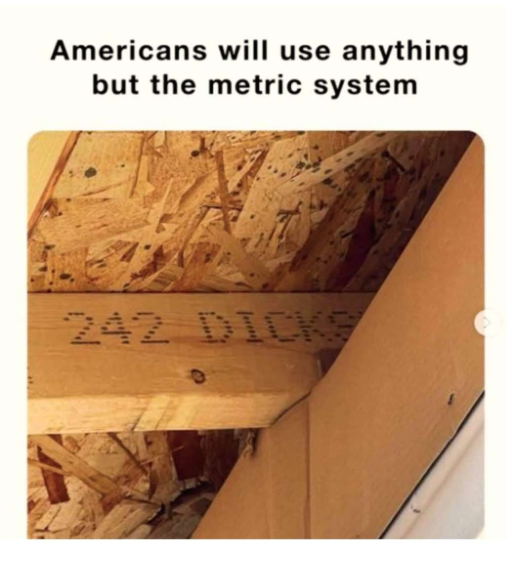Those aren’t supposed to be round on top.
Everyone should get awnings instead of bruteforcing the heat away. The insulation in your walls works both ways: it doesn’t let heat out in the winter and inside in the summer. However, the sun’s radiation passes through windows without much holding it back (without awnings or external curtains) and directly heats your home from the inside. So your house is basically a greenhouse when there’s nothing covering your windows.
Happy cake day.
My HOA would not approve of awnings.
We do have the latest version of low-E Windows. They’re shockingly effective.
I really want to get motorized blinds, and motorized forced air vents, as it sits now, we more or less just leave all the windows covered. Given it’s not as effective from the inside, But even reducing the direct IR mission makes a big difference.
36.5°c for people who use sane units ;)
I hate were i live, it’s our coldest time in the year and tomorrow’s high is 32.
36 is normal during the hot time of year along with massive humidity too
As much as I like the metric system, temperature in the world is the one place where I prefer Fahrenheit. Having to care about decimal points on a thermostat just seems like trying too hard. “Oh honey, could you turn the thermostat down to 21.1C?”
You know that 100 is hot as balls. You know 0 is cold AF. 0C is 32F. That’s not really that cold, I’m shoveling snow in a t-shirt. 0F is really that cold. It is almost more akin to a percent of comfort scale than a measurement of temperature.
It is an interesting thought experiment though, as anyone using a given measurement scale gets used to it over time. I’ve been doing dual for a while to better intuit fuzzy translations in my head without having to run a formula every time.
Just an opinion of course, and not trying to have some flagrant discussion. I’d gladly switch to Celsius if we ever finally left Freedom Units. Thus far, the only places you see it in the US is in science, medical, and pop companies selling 16.9fl oz (just shy of 500ml) beverages instead of 20, so they can milk their bubble sugar water for all the profits.
No one calls out decimals in Celsius. Unless you are measuring your kids fever. 38.1 vs 38.5 vs 38.9 you know that it’s time to ready the metamizole if it keeps creeping up like that
0°C is the frost point of water. If you know it will dip below that during the night, you can prepare your plants, driveway, kids (I’m sorry my love summer is over), pets, clothes, etc the day prior.
-40° is -40° though, doesn’t matter if it’s F or C. The best part of both scales.
Copying this post I made elsewhere recently:
I used to say this. But being a curious person, and one willing to test my own hypothesis, I decided to learn Celsius. Like, spend enough time with it to intuitively understand it, so that I could compare the two.
Almost six years later, I haven’t switched back. I much prefer Celsius for weather. Having 0° at freezing is far more useful than I suspected it would be, and having less granular degrees gives them more meaning, which makes understanding them easier.
Seriously, I struggle to express just how useful below-freezing temperatures being negative is. -5°C means so much more to me than 23°F, and that’s after thirty years of using Fahrenheit and only six of using Celsius.
Edit: this isn’t to discount what you’re saying, just to offer my own opinion on the matter. Having experienced both, I much prefer Celsius. But obviously everyone will have their own opinions.
I often hear americans (even scientists) say that they prefer the Fahrenheit scale for weather forecasts, but I believe the perceived higher accuracy is an illusion. Forecasts aren’t that accurate for any given micro climate.
For example, I don’t care if my weather forecast says 26°C or 28°C, I know it’s “short sleeves” weather and when I look at a few graphs at the end of the day, it’s been 25.6°C two meters above ground 100 meters south of me and 27.3°C in the garden, but only for 5 minutes etc.
I often hear americans (even scientists) say that they prefer the Fahrenheit scale for weather forecasts, but I believe the perceived higher accuracy is an illusion. Forecasts aren’t that accurate for any given micro climate.
When I switched from Fahrenheit to Celsius I used a rough heuristic to get the Fahrenheit value from Celsius. What I discovered was that my heuristic, which was rounded and would skip entire degrees Fahrenheit, matched most weather apps’ Fahrenheit value.
For example, if my app said 20°C, the other person’s said 68°F. If mine said 21°C, theirs said 70°F. If mine said 22°C, theirs said 72°F. If mine said 23°C, theirs said 73°F. It is very rare that mine has said, say, 21°C and theirs has said 69°F (or any temperature where the value was converted with decimals and then rounded).
That is to say, my experience certainly seems to indicate that for people using the same weather sources but in Fahrenheit, the value was still rounded to the nearest degree Celsius, then converted to Fahrenheit and rounded again.
That’s not to say you’ll never see 71°F or 69°F or other values that aren’t converted from an already rounded Celsius value, it all depends on what your data source is providing you. But nearly always, my rounded conversion from a rounded Celsius value matches what other people see in Fahrenheit.
This makes complete sense, because most people cannot tell the difference between 70°F and 71°F. And it’s difficult to predict regardless.
Edit: this could also just be a lack of sampling and dearth of values where the rounded-converted-rounded value differs from the converted-then-rounded value. I don’t know.
Nah, I agree 100%. Celsius is wonderful for computers and science, but the human-tolerable range is far too small. Fahrenheit is a human-based scale, with 0-100 basically corresponding to a percentage of how much heat a person is able to/forced to hold onto. At 0, you’re not really able to hold onto any heat; you quickly reach hypothermia. At 100, you’re forced to keep nearly all of your heat, and are only able to vent trace amounts; you quickly reach hyperthermia.
It turns out, people function best when they’re keeping 40-70% of their heat (depending on how they’re acclimatized, which is determined by how much brown fat they have), so those are the temperatures that are most comfortable for us.
I agree with the sentiment but -40F to 120F would do the job better
Thank you! 😃
Imagine having to use a decimal to account for a lower resolution measurement.
I’m team metric for everything but temperature when relating to human environments.
Imagine replying to a comment 36 hours after the fact and not even having a cursory look at the comment chain to see what else has been said.
We don’t use decimals in everyday life, you don’t need to.
It was mostly a joke? I’m sorry I didn’t do a /joke to verbalize that.
I’m sorry I’m not chronically online. My “active” filter is about 12-30 hour old so I’m not chronically online as much as I was on Reddit. This is like a forum. Let’s not criticize people for not reacting quickly, please.
My apologies, I didn’t realise it was a joke seen as most people in this thread aren’t joking when they say things like that.
I don’t blame you for not chronically being online, that is a good thing rather than a bad thing, but if you were using it as a forum would you reply to a thread without actually reading through the rest of the conversation? The snide comment was mostly because I thought you were being serious and each of your points has been gone over multiple times within the tree of my original comment so I thought you were being intentionally belligerent.
Thanks so much for the chill reply :)
I’m too ADHD in that I don’t have as the replies like a conversation and reply without reading the other replies. I’ll do better to get more context before reacting quickly in the future.
You do realize the reason fahrenheit is set up that way, is based on the human perception of temperature. 0-100 is the general range or cold to hot. Of course some inhabited areas end up outside that range a bit, because humans are adaptable but generally speaking it allows for far more graduation in every day real world scenarios. Metric is good for science, but not ideal for casual everyday usage of hot and cold.
Your body doesn’t really care what the boiling point or freezing point of water is. But you should and generally do need to preemptively plan for environments outside the fahrenheit scale.
You do realize the reason fahrenheit is set up that way, is based on the human perception of temperature. 0-100 is the general range or cold to hot.
That is not why fahrenheit works the way it does. This is something Americans have appropriated as a silly and poor excuse for using it. “cold” and “hot” are completely arbitrary and subjective terms, and the 0-100 range is as arbitrary.
Metric is good for science, but not ideal for casual everyday usage of hot and cold.
That will come as a surprise to the billions of people using it every day for exactly that purpose. You are projecting your own ignorance over billions of people, because you yourself have no idea how it works.
That is not why fahrenheit works the way it does
You’re entirely right, but it’s fun to trigger people like you with a couple words that ultimately mean nothing.
You are projecting your own ignorance over billions of people, because you yourself have no idea how it works.
You mistake ignorance for simply not giving a fuck. I know what Celsius is, I know how it converts, I just don’t care.
It’s very entertaining to be able to trigger people at will to crawl out of the like bugs and talk shit online, wasting their time on a topic that doesn’t matter in the slightest. It’s usually the Europeans, they seem to have a superiority complex about this specifically for some reason and love typing at length about it. Most other countries outside the EU region don’t bother, probably because it doesn’t matter.
Also, here’s the obligatory reminder to the Europeans that the US began using metric in 1866 and officially switched to the metric system in 1975, it just wasn’t made mandatory to switch, so most didn’t. Because it doesn’t really matter for daily life which system is used.
It’s very entertaining to be able to trigger people at will to crawl out of the like bugs and talk shit online
Uhhh so edgy
Epic projection comment. How very much your multi paragraph reply screams “I don’t care”.
You sure write a lot for someone who just doesn’t care
Lots of downtime at work at 3am. Might as well poke the Europeans since they’re awake.
Oh, just can it, American.
Hey. Remember when the beagle spacecraft totally slammed into the Martian countryside because someone used imperial units? 2 year wait for some good times.
slammed into the Martian countryside
At least it avoided the Martian urban areas.
Ah, well here’s another one of those down votes you were looking for.
Side note, I’m American. After getting a mechanical engineering degree is was clear to me that metric is just better. Maybe it doesn’t matter to you, maybe it doesn’t matter to most people, but if you actually have to spend time thinking about this stuff then it starts to matter.

Your body doesn’t really care what the boiling point or freezing point of water is.
Yes it does.
Maybe Fahrenheit is really for tardigrades. Those don’t really care about the freezing temperature of water.
No, the human perception of temperature thing is a myth. Originally 0F is the freezing temperature of a brine solution, and 90F was Fahrenheit’s estimation on the average human body temperature, and then the scale was adjusted so that it fit in better with Celsius reference points (freezing/boiling points of water).
Reference: https://en.wikipedia.org/wiki/Fahrenheit
So it’s all a hack.
Like half of the things American.
You do realize the reason fahrenheit is set up that way, is based on the human perception of temperature. 0-100 is the general range or cold to hot.
You do realize that Celsius is set up based on known, objective, & measurable data points instead of subjective things like “hot” and “cold”.

The 9 and 100 in F is a completely random range, where 0 is a random solution freezing point and 100 was an estimation. Tell me how it’s better than C, tied to water, the main stuff we all need to live in this planet and probably also for aliens in other planets.
If that was true, then we wouldn’t see people bitching about the cold while I’m out in a t-shirt and jeans in 50°F weather. Seems fucking stupid to base a measurement system on something so subjective.
I personally would use Kelvin for science, Celsius is much more useful for everyday things like whether it will rain or snow, whether the paths will be icy, how hot it will be according to the weather report and how hot to make stuff when boiling water or cooking. Kelvin is great for not having negative temperatures which don’t make sense.
Is that a Dell. Lol.
Rofl, might as well be. Was just hope after I replace it It doesn’t swell again just like dell.
Have you tried unplugging it and plugging it back in?
Looking at the power draw from 8am to 1pm, it did that itself every 5 minutes.
replaced the cap, it’s chill now.
That’s pretty cool.
Yep, if your condenser unit outside just won’t turn on it’s always a good idea to check this capacitor. I think it was just last year that I replaced the one in my unit installed in 2015. I went through a few capacitors with the ancient system before that!
Well there’s your problem right there!
It was! Came right back!
This is me, today. House is 88 F. Service won’t arrive until Monday.
Last year mine conked out during a 100+° day. I tried everything! I’m talking cold(ground was still hot so it was actually a cool shower) then frozen water bottles in my pits, crotch, and neck. I ended up going to a cheap motel for the night and discover my door knob was actually hotter inside than out.
Yeah, I identify with this. Outside is cooler than inside. I would do a motel but 3 dogs is a no-go for places near me. They won’t stay outside either, silly things want to be inside with me.
What is that?
It’s a large capacitor. They are used in those big outdoor AC units to kick start the
fancompressor. Being outdoors and subject to large temperature changes and vibrations for years they inevitably fail.https://static.homeguide.com/assets/images/content/homeguide-technician-replacing-ac-capacitor.jpg
They are to help start the compressor, not the fan. Anything with a compressor will have one, like your fridge.
The fan motors will often also have them. It just depends on the size and type of motor. Most big AC motors use them unless you’re dealing with 3 phase power.
They are used for the evap coils fan as well.
Ah, you’re right. Got it mixed up with furnace fans which have smaller caps.
I’m assuming that it’s some sort of component from the air conditioner, but damned if I know what it is. Looks like power plugs on it, and someone else mentioned “caps”, so maybe a capacitor, though I wasn’t aware that there was some kind of plug standard for large removable capacitors.
kagis
Yeah, this capacitor looks similar.

EDIT: Apparently air conditioners can use large capacitors:
https://www.amazon.com/Capacitor-Conditioner-Multi-Purpose-Capacitor-5-Warranty/dp/B092ZQ3Y3N
Capacitor for Air Conditioner 5 uf MFD 370 or 440 Volt VAC, Multi-Purpose Round Capacitor for AC Motor Run or Fan Motor Start or Condenser Straight
EDIT2: Oh, I bet I know what it’s for, given the “Fan Motor Start” and what I assume is a misspelled “Condenser Start” text on the Amazon listing. Some hardware will draw a lot of juice when starting up. Laser printers are prone to this, for example. The references above are to mechanical things, moving components, and maybe one need extra power to overcome static friction, to get the parts in motion initially; once moving, they face (lesser) kinetic friction. One option is to just draw a ton of power from the line, but then that increases the peak power demands of a device. Another option, gentler on whatever circuit or external power source is providing the power, is to charge a capacitor for a bit and that’ll let you create a big surge of available power for a moment without having to have higher peak demands on the external power source. Adds to device cost, but limits its peak draw.
Not quite- these motor capacitors provide a phase shift for a second set of windings. Without it, the motor will just hum and not rotate.
You are describing bulk or filter capacitors that go from supply to common on a DC circuit, parallel to the load. These motor caps are on AC and in series with the load.
Gotcha, thanks!
At last it’s an inexpensive and easy fix. Just buy another capacitor with the same specs and swap them out. Better yet, buy two! Keep one as a backup.
Don’t buy an electrolytic capacitor as back up and store then over a long time. They will degrade and will be bad when you finally need them.
MKP/MKT capacitors are an exception since they don’t degrade the same.
Eh, they do age but a spare capacitor sitting in a likely climate controlled building and not being used isn’t going to age nearly as quickly as the one in use likely in the outdoors. Will it be as good as a brand new one? No. But it will be damn near as good and it will be on hand when you need it.
At the same time though, if a motor kills start components often enough that you need to keep a spare on hand then there is something wrong with that motor or your power source.
Yeah, I bought one to make sure that was the only problem. It just came back up so, now I’ll pull the furnace apart and find what size it uses for the blower keep them both on hand.
They can blow on their own but chances are you have a junk contactor or a fan that draws too much amperage.
It’s also possible a critter shorted the contacts. Happens all the time in Florida. Usually the fried lizard is still there.
True enough.
3 year old unit :(
Then it certainly shouldn’t have failed yet so either high cycle rate or high draw.
Clean both coils and keep watch on how often it runs and how long it stays running for a couple weeks. Also if you still have a analog bimetallic thermostat those can fail and cause rapid cycling and if the compressor isn’t smart enough to delay they can cycle themselves to death.
keep watch on how often it runs and how long it stays running for a couple weeks. Also if you still have a analog bimetallic thermostat those can
It’s on an ecobee which appears to be behaving, pulling data from homeassistant on emporia power, it seems to be pretty chill.

she’s 1.5 ton pulling 1300 watts while running which actually seems low to me.
If there are other start components then those should also be swapped. One component failing can weaken the others, especially the start relay.
As much as that sucks, you clearly already know the fix and are working on it. Grats to you for having the skills bro. Please work safe, 2 phase electricity doesn’t play around.
For an european that sounds unbearable, but i have to translate to celcius
At 98.6 it would be the same temperature in my anus as it is in my air.
About 37
Your upstairs must be literally boiling.
Or damn near freezing
After replacing the capacitor I set the thermostat to zero Kelvin
Only a Sith deals in absolute zeros!
It’s not a fix an HVAC tech would tell you how to do.
Nah, “freedom” units there’s a whole other human’s worth of temperature before it actually boils.
What am I looking at?
Motor capacitor for an A/C compressor. A $15 part that a service company is going to charge $400 for a guy missing most of his teeth to replace in 2 minutes.
When I used to fix cars for a dealership we would sometimes have the service advisor ask us to do work for free. “Come on, it’ll just take you ten minutes!”
I’d tell them that they can do it themselves if it only takes ten minutes. “But I don’t know how to do that!”
You’re not just paying for the part, you’re paying for the knowledge, time, and tools of the technician.
And to be completely honest, if you call an HVAC repair company, they’re likely to do a whole PM cycle on it. Flush the condensate line and pan, clean the coils and the heat exchanger, replace the contactor if you have one, take the temperature differential to make sure the unit is operating reasonably well, replace the blower belt it’s not direct drive. I PM the unit myself every spring and fall. I probably should have had eyes on that cap though.
Yeah, testing caps is also a pretty regular part of our PM process. Especially because that one looks like it may partially be a run cap and a system can often run perfectly fine without a run cap except it will cause the motor to pull higher amps and run hotter. Catching a bad run cap early is the difference between replacing a bad cap and replacing a burned up motor.
Edit: Although you’re already doing far more for your system than most. I’m an actual tech and it’s been a shamefully long time since my equipment at home has had a full PM done.
That’s good to hear, thanks for that. Yes it’s a dual cap. I’ll have to dig out my LC meter and add that to my list.
It was a new build, my old plays I didn’t stay on top of things and ended up paying for it. I decided to do a better job here.
My very first maintenance I went down to look at what I needed to do. It’s a trane unit, so the evaporator coil and the condensate pan come out on a slide which is pretty fancy. The condensate line, combustion and exhaust air are all PVC and they glued it all so you couldn’t get the tray out. (The air lines don’t even go into the box they just ran it past the front for spite I think)
Hope you don’t mind if I ask you two questions, not holding you accountable or anything.
What are you guys using for condenser coil cleaner? I just got some off-the-shelf home Depot stuff but it looks sus. I pulled the case and separated the coils out at the two-year mark and followed the instructions on the cleaner. I didn’t see any physical dirt anywhere and there’s no leaves or debris. Without physical dust dirt or debris do you think just hosing it down from the outside on PM is fine?
My very first maintenance I went down to look at what I needed to do. It’s a trane unit, so the evaporator coil and the condensate pan come out on a slide which is pretty fancy.
If it’s the style I’m thinking of then you are flexing the refrigerant pipes whenever you do that. It’s designed to do that but just be aware that copper work hardens so you can only flex it so many times before it gets brittle and snaps. With your system being new there isn’t too much risk of snapping a line but it won’t be new forever. If it is possible to clean the evap without bending those pipes then that is the best way to do it.
As far as coil cleaner goes the most we ever recommend one of our customers use is just plain water out of a gardenhose (definitely not a pressurewasher). For most people that should be enough. But you’re not my customer so here’s what I use depending on the coil.
For small evap coils like a residential central air system I often use Evap Foam No Rinse. That stuff is pretty gentle and probably fine for most people to use. If kills any growth on the coil and foams up to push dirt out of the coil. Once applied it doesn’t need to be actively rinsed off because it’s designed to be rinsed off just by the condensation that builds up on the coil as the system runs.
For larger evap coils like in commercial roof top units or more heavily soiled evaps I will use either Tri-Pow’r HD or Evap Pow’r-C. I’ve found both to be about equally as effective but the evap cleaner does foam up a bit more. Both are still fairly safe to use but if you mix them more concentrated then you do need to actively rinse off the coil well when you’re done. I have a hard time imagining anyone breaking anything with either of these but technically they can do damage if left on the coil for too long.
When it comes to the new style microchannel condensers, heavily degraded older style fin and tube condensers, or lightly soiled older style condensers, I will also use Tri-Pow’r HD except I will mix it much stronger.
When it comes to heavily soiled older style fin and tube condensers which are otherwise in good physical shape I will use Nu-Brite. Nu-Brite is nasty shit. It will instantly burn skin, melt plastic, strip any oxidation off of metal, etch concrete, strip paint, strip the coating entirely off a coated coil, and, if left on a coil long enough, etch holes through the condenser pipes forcing you to buy a whole new condensing unit. It literally starts to smoke if it sits on the coil too long. It is aggressive as hell but man does it clean coils. I was working at a flour mill recently and made extensive use of this stuff to clean mouldering packed in flour mud out of condensers and it takes no time at all to do it’s job even with the worst soils. This stuff is perfectly safe to use if you use it right but if you don’t use it right then there is basically no fixing the damage it does. If you ever did decide to use it, just be sure to have a hose nearby ready to hose it off as quick and completely as possible. Once it starts foaming and smoking it has started doing damage.
Thank you so much taking the time to write all that, its truly useful information… I would have completely overlooked the no rinse stuff for fear it was a sales gimmick.
I think I’ll probably hose wash down every season, foam it If the water coming off has anything in it and save the teardown for 5-year or special event.
There’s not really much here in the way of sand or dust. It’s mounted off the ground. The hose should be able to get smoke particulate and pollen off.
Thanks again.
for a guy missing most of his teeth to replace in 2 minutes
A good reminder to not test unknown capacitors with the tip of your tongue.
It’s going to depend on the area, but it shouldn’t cost quite that much for residential work. Hell, I’m a commercial refrigeration/hvac mechanic and my bill would still be less for that repair. You actually made me curious so I priced it out. TLDR if you don’t want to read below it comes out to $310 before taxes. So unless you’re in a stupidly expensive area your price should be under that for this repair from a residential HVAC tech. My best guess is that it would cost about $250 in my somewhat low cost of living area if done properly by a residential tech.
Price breakdown-
We upcharge a bit on parts depending on their cost (cheaper parts are upcharged more) but we also get a discounted price from the supply house so the actual upcharge amount is a bit weird to calculate. We do have one of these caps in our system (its 440V instead but oversizing doesn’t hurt) and our unit price (markup included) on it is $25. If this system has other start components then you would want to change those as well but I don’t know what this system looks like so I’m going to assume that only this cap is needed. Depending on the distance from the shop we charge a one time truck charge. However the main reason we have variable truck charges is because we’re more specialized and some of our customers are over 200 miles from our shop. Odds are for residential work you’d be working with a local company and for local work we charge our minimum truck charge of $45. If this was durring business hours then we charge $120 per hour. Afterhours rates are much higher of course but usually nobody is calling a tech afterhours to work on residential AC. Drive times to and from the site are included in the billed hours.
As far as time required a quick cap swap could easily be within our 1 hour minimum depending on drive time to the site but with this situation I would guess 2 hours may be more likely for reasons I’m about to explain. The cap is obviously bulged so any tech worth their salt would pinpoint it immediately. Of course any tech worth their salt is also going to check out the other components to ensure that there isn’t a reason the cap blew. That means checking contactors, compressor windings, and ither caps. Once the new cap is installed that also means checking running amps and inrush current. While you’re at it you’ll want to at least check refrigerant line temps because that’ll give you a rough read on the system charge and state of the coils. For this unit I wouldn’t be hooking gauges up unless something was off with the temps and couldn’t be easily explained. It’s also just a good idea to watch the system run for a bit and make sure it cycles on/off correctly to make sure it’s not short cycling or something. With all that you could be looking at an hour onsite. Depending on the system and the delays you can’t really shave that down much if the tech is going to be able to see the unit run. If you cut out watching the system run basically entirely you can shave 30min off that but that’s also a sure fire way to get a callback for something you didn’t catch. The bigger issue though is that this is a dual value cap. It isn’t going to be standard van stock and until the tech gets onsite they won’t know what cap they need. So you’re looking at that tech also having to make a trip back to the shop to pick up the correct cap. I carry universal caps in my van but those are much more expensive so they’re really only for emergency repairs or to temporarily run a system if we need to order a specific cap. So if we assume 15min from the shop to the customer and the tech has to make that trip 4 times (out to customer, back to get part, back to customer, and back to shop when done) then were looking at an hour just in drive time.
So in total we have 2 hours of $120 per hour labor + $45 truck charge + $25 part = $310 plus relevant taxes.
I used to work as an ac parts coordinator in a very affluent area. I know what they cost and those bills these people were paying were disgusting!
mine went out in July in Phoenix, AZ. The 3rd closest Ace had 1 in stock for my unit.
When you go upstairs do you constantly hear “Give Me Just One Night” or something in the background?
I do but unfortunately the announcer just keeps talking right up to the post.






















